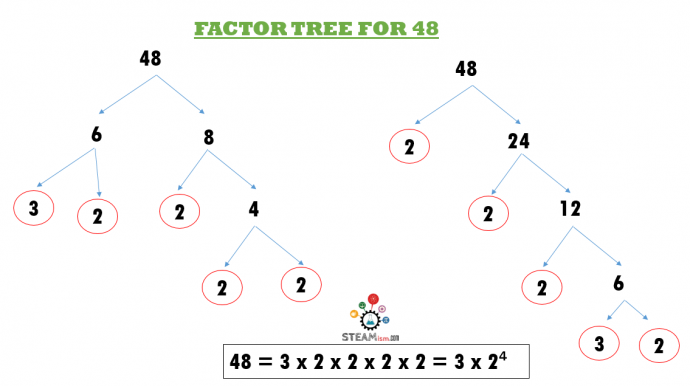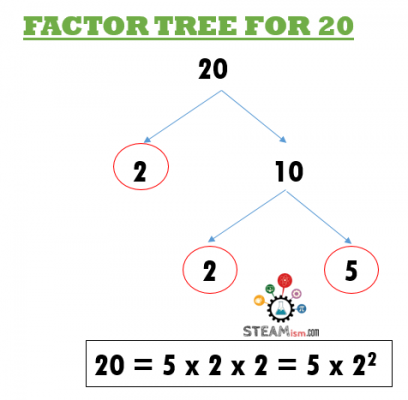What are “factors”?
“Factors” are the numbers you multiply together to get another number.
Example 1: let’s take the number 6.What are its factors?
- 6 = 1 x 6
- 6 = 2 x 3.
So, the factors of 6 are 1, 2, 3 and 6.
Example 2: Now, let’s try a larger number – what are the factors of 48? What are all the ways you can break it down into its multiples?
- 48 = 1 x 48
- 48 = 2 x 24
- 48 = 3 x 16
- 48 = 4 x 12
- 48 = 6 x 8
So, the factors of 48 are 1, 2, 3, 4, 6, 8, 12, 16, 24, 48.
Quick refresher on primes
For a quick recap, read this article: prime numbers are numbers with only 2 factors, 1 and the number itself.
So, for example, let’s try factoring these 2 numbers: 11 and 97
Example 1: What are the factors of 11?
- 11 = 1 X 11
So, the only factors are 11 and 1, making it a prime number.
Example 2: What are the factors of 97?
Use your divisibility tricks to see if it has any factors: Divisibility Rules – Easy shortcuts
- 97 = 1 X 97
So, again the only factors are 97 and 1, making it a prime number.
What is prime factoring or prime factorization?
“Prime Factorization” is figuring out which prime numbers multiply together to make the original number. Every number has an unique set of prime factors that make it up.
As you’ve learnt, factoring a number simply means breaking it into pieces. Prime factoring a number means breaking a number down into its prime factors.
Examples – as we saw above:
- Example 1: 6 = 2 x 3. So the prime factors of 6 are: 2 x 3
- Example 2: 48 = 6 x 8
- Break it down until you reach all the primes: 2 x 3 x 2 x 4
- Keep going – 4 is not a prime: 2 x 3 x 2 x 2 x 2. All primes now, great job!
- Rearrange so all like primes are together: 2 x 2 x 2 x 2 x 3.
- If you’ve learnt exponents, now’s the time to combine like terms and express as an exponent: 24 x 3
- Example 3: 11 = 11. That’s as far as we can go since it’s a prime.
- Example 4: 97 = 97. Same here, it’s a prime so it has only one factor.
Factoring Tree
Let’s look at Example 2 above again, shall we?
48 = 2 x 2 x 2 x 2 x 3.
This can get painful if it’s a larger number or if you have to keep breaking it down into primes, right?
Thankfully, there’s a much more graphic and fun way to do this. It’s called a factoring tree.
What are these factor trees? What grows on them? Anything I eat?
A factor tree is a tool that breaks down any number into its smallest possible factors. So, let’s look at some examples of factor trees.
Example 1: Factor Tree for 48. Yes, you can start anywhere – just keep breaking down until you reach a prime.

Example 2: Factor Tree for 20

Go ahead and try some on your own! Once you get the idea behind it, it gets really easy and then we can start practicing our next skill: GCFs and LCMs.
Click here to learn about Greatest Common Factors (GCFs)
- How To Write A Lab Report - April 8, 2023
- The States (Phases) of Matter - June 9, 2020
- What is Engineering? - June 2, 2020
